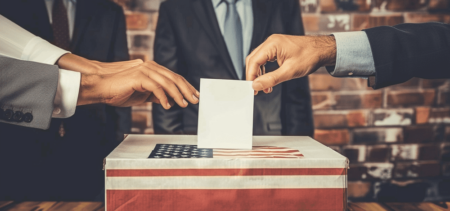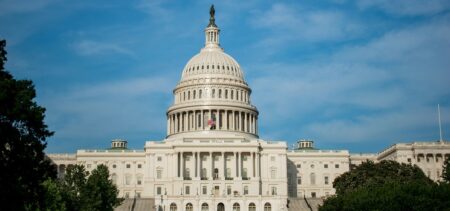US government shutdowns disrupt the economy and leave thousands of workers unpaid. Additionally, these standstills negatively impact air travel, the Internal Revenue Service (IRS), small businesses, and many more government programs. This article will explore what US government shutdowns are, how they affect federal employees and services, and how Congress is responding to the risk of these economic standstills.
What Is a Government Shutdown?
A government shutdown occurs when US leaders cannot agree on budget spending for the following fiscal year. Consequently, non-essential government agencies stop operating, putting thousands of workers on furlough and closing all delivery channels.
The US federal budget process typically begins with agreements and cooperation between all government stakeholders—the President, the House, the Senate, and the federal agencies receiving the funding. However, this process is often complicated and drawn out. When these lawmakers cannot agree, the government implements a continuing funding resolution, which is temporary legislation to maintain current funding and keep the government open. Yet, if this strategy fails, the US government will impose a nationwide shutdown.
How Do Government Shutdowns Affect Federal Employees?
When US government shutdowns occur, employees are categorized into essential and non-essential workers. Essential workers provide services (hospitals, law enforcement, border patrol, etc.) that the safety and health of society rely on. As a result, these employees must continue operations, however, they will not receive compensation unless a specific bill is passed to fund these salaries.
In fact, The Washington Post confirms that during the previous shutdown in 2019, only around 100,000 essential employees were working with pay compared to 400,000 working without compensation.
On the other hand, non-essential government agencies are not as equally and imminently imperative to the safety and health of society. Because of this, these organizations will cease operation during a shutdown and place their workers on unpaid leave.
The same data by The Washington Post indicates that more than 250,000 employees were furloughed in 2019.
Non-Essential Federal Agencies
Over ten non-essential government agencies do not operate during shutdowns, including
- National Institute of Health (NIH)
- Department of Education (ED)
- Environmental Protection Agency (EPA)
- Food and Drug Administration (FDA)
- Health and Human Services (HHS)
- Department of Labor (DOL)
- Department of Housing and Urban Development (HUD)
- Department of Interior (DOI)
- Internal Revenue Service (IRS)
- National Aeronautics and Space Administration (NASA)
- Department of Commerce (DOC)—excluding the National Oceanic and Atmospheric Administration.
- Department of Energy (DOE)—excluding those overseeing nuclear dams, transmission lines, and arsenal.
Essential Federal Agencies
Only six essential government agencies operate during shutdowns, including
- US Customs and Border Protection (CBP)
- National Safety, Security, and Defense
- US Postal Service (USPS)—they can access a different source of funds.
- Transportation Security Administration (TSA)
- US Department of Justice (DOJ)—besides gun insurance as this service will be suspended.
- Social Security, Medicare, and Medicaid—funding is automatically included in the mandatory budget.
Which Programs Are Impacted by Government Shutdowns?
As US government shutdowns indicate a lack of funding, many government services and programs will not have the budget to operate. While some services may continue, most will temporarily suspend until the federal budget is announced.
Here is an overview of how government programs and services are affected by shutdowns.
- Medicare and Social Security Checks: Applicants will still receive their checks, however, credit card insurance and verifications for benefits will no longer operate.
- Air Travel: Travel may be temporarily discontinued at some airports, while those that remain open will suffer considerable delays due to staff shortages.
- Health and Human Services: The National Institute of Health (NIH) will not admit new patients in medical studies or approve grant applications. However, in the 2013 US government shutdown, many states had no choice but to provide funds for critical grant programs, like Temporary Assistance for Needy Families (TANF).
- Veteran Services: Clinics and medical centers for Veterans will remain open, while Veteran call centers and hotlines will stop operations. Unfortunately, this includes the Veterans Benefits Administration call center.
- Small Businesses: Federal loans for small businesses will stop, including loan approvals and submissions. In addition, hiring will drastically slow down as the federal E-verify platform will shut down, and there will be limited IRA assistance.
- National Parks: Although all national parks stopped operation in the 2013 US government shutdown (and this is a non-essential service), many remained open during the following government standstill five years later. The reason for this—these tourist attractions lost too much revenue in 2013. However, if they remain open, national parks will not have the workforce to offer cleaning and visitor services. Therefore, waste build-up and damage are likely to occur.
- Internal Revenue Service (IRS): While IRS employees are categorized as “unessential”, in the 2019 shutdown, President Trump requested tax workers continue operations to implement the new tax laws. Nonetheless, the IRS will still face severe backlogs in tax returns and loan and mortgage approvals, as many employees refuse to work without pay.
- Military Personnel: Military professionals will continue operations as usual, without any gaps in their pay. If lawmakers severely delay the federal budget, they will pass separate spending bills to fund military operations in the interim.
How Many Times Has The Government Had a Shutdown?
According to ThoughtCo., the US government has experienced 21 shutdowns between 1976 and 2023. The report indicates that the most prolonged shutdown is also the most recent—under President Trump, the US ceased operations for 34 days between December 2018 and January 2019.
Furthermore, the ABC News Network confirms that since the last shutdown, the government has come close to several others every fiscal year. And US lawmakers continuously exhaust all possible resolutions before agreeing on funding legislation. The primary cause of these shutdowns is disputes between government stakeholders, which also led to the 2019 standstill. Although President Trump requested over $5 billion in federal funds to build the US-Mexico border wall, Democrats refused to pass this budget. As a result, the US government was in a deadlock between the White House and Congress for over a month.
Furthermore, various Democrats and Republicans submitted proposals to end the shutdown, but President Trump maintained his position on federal budgets for the concrete wall. Fortunately, the president reopened the economy. And while the wall would not receive funding, Congress opened negotiations for different immigration and border security measures as a compromise.
What Can Congress Do to Prevent Shutdowns?
Following the $11 billion economic loss suffered by the federal government during the 2019 shutdown, numerous Republican and Democratic senators have proposed potential solutions to eliminate the risk of future shutdowns.
Democratic Senator Mack Warner of Virginia has introduced the Stop STUPIDITY (Shutdowns Transferring Unnecessary Pain and Inflicting Damage In The Coming Years) Act. This bill encourages the government to maintain current funding levels and adjust them based on inflation, but, the executive and legislative branches will not receive funding. According to Senator Warner, this aggressive approach prevents future standoffs between the White House and Congress.
On the other side of the political spectrum—Republican Senator Rob Portman of Ohio submitted the “End Government Shutdowns Act”. Senator Portman claims an effective resolution to shutdowns is to manage current funding and incentivize Congress to pass funding legislation as quickly as possible. If Congress cannot agree on funding legislation, after 120 days, the initial funding balance will fall by 1%; after another 90 days, the budget will undergo a second 1% cut. This 90-day cycle will continue until the government has passed a federal budget.
Despite these proposals, no definite direction has been established to eliminate the risk of future shutdowns.
Will There Be a Shutdown in 2023?
The US government began the 2023 federal budget year on October 1st, 2022, and since has employed several short-term spending bills to avert a shutdown. By December 29th, 2022, after drawn-out negotiations, US lawmakers passed a $1.7 trillion spending budget for the current fiscal year. While a shutdown will not occur in 2023, there is no guarantee that the government will avoid one in the coming years.
Nationwide shutdowns have been a possibility looming over US lawmakers since the first government standstill in 2013. And while many leaders have shared proposals to eliminate shutdowns, none have been formalized. Ultimately, how likely another shutdown is to occur depends on how quickly and successfully Congress agrees on the best direction forward.














































